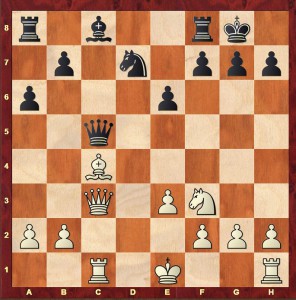A little while after posting about Alekhine’s inventiveness in the early opening stages (Alekhine’s Themes – at you right from the opening!) I came across another lovely little example which I just have to share with you. It comes from the game Alekhine – Vidmar Hastings 1936.

After 13 moves of a quiet QGD, Black is doing reasonably OK although White’s c-file pressure gives him any initiative going in the position.
14.Bb3 b6
Black is hoping for a quiet life after 15.0–0 Bb7. Typically for him, Alekhine senses his last chance to inject some tension and uncertainty into the position and thus force Black to calculate concretely.
15.Qd2
The first dilemma for Black. Ideally Black’s queen would retreat to e7, covering the central and queenside dark-squares (especially c7 and d6) left exposed by the exchange of the dark-squared bishops. However, after 15…Qe7, Black has to evaluate 16.Rc7 accurately. After a move like 16…Qd8, White can try 17.Qd6 to keep Black bottled in. Isn’t it strange? After move 14, Black was looking forward to the exchange of queens and an easy game. Now a move later, he needs to evaluate precisely whether the most desirable move is possible.
15…Qh5
Vidmar didn’t think he could get away with 15…Qe7 – or didn’t want to retreat and concede ground to Alekhine – and keeps his queen active for counterplay on the kingside. The pressure of the queen on the knight on f3 adds strength to follow-ups like …Ne5 and …Bb7.
It’s an understandable choice although 15…Qe7 was indeed a better path to equality for Black. The key point is to meet 16.Rc7 Qd8 17.Qd6 with 17…Nc5.
After 18.Qxd8 (18.Qxb6 Nd3+ 19.Ke2 Nxb2 (19…a5 also looks interesting with …Ba6 to follow) ) 18…Rxd8 19.0–0 (19.Ke2 Bb7 20.Ne5 Rac8 equalises as the king on e2 is a little exposed 21.Rxf7 Nxb3) 19…Nxb3 20.axb3 Bd7 is fine for Black.
15…Qh5 is tactically justified as the attempt to win 2 pieces for a rook with 16.Rxc8 loses to 16…Raxc8 17.Qxd7 Rfd8 18.Qe7 Rc1+ 19.Ke2 Qb5+. Apart from …Ne5 and / or …Bb7 combining with the queen against the White knight on f3, Black also intends …Nc5 followed by …Bb7 or even …a5 cementing the position of the knight on c5. Note how alertly Alekhine reacts to these ideas. With his next move, White
- renders Black’s c5 outpost for his knight unstable
- Protects his knight on f3 prophylactically against any Black play with …Ne5 or …Bb7.
- Introduces both a tactical threat (a discovered attack by the knight on the queen on h5) and a positional threat (the transfer of the light-squared bishop to the strong h1–a8 diagonal with gain of tempo after Nd4 and Bf3).
Once again, no routine play from Alekhine. If pieces need to be moved multiple times in the opening, or castling needs to be postponed for immediate concrete action, Alekhine sees it!
16.Bd1
Lovely! White makes b4 possible in response to …Nc5, introduces the positional threat of Nd4 and Bf3 and also increases the chance of success of Rxc8 and Qxd7 as the bishop on d1 blocks any Black rook check from the c-file. Black must find a way of developing his queenside. In general, that means that the knight should move from d7. In the game Vidmar played 16…Nc5 but did not manage to equalise after 17.b4. I examined 4 other moves:
- 16…Ne5
Black is looking to follow up with …Bb7 but he’ll never get the chance. You see how useful 16.Bd1 has been!
17.Qd6 Nxf3+ 18.Bxf3 Qa5+ 19.b4 Qa3 20.0–0 wins
- 16…Nf6
This is a concession of sorts from Black as he abandons the use of the active c5 outpost for his knight.
17.Nd4 Qd5 (17…Qg6 18.Bf3 Ne4 19.Nc6 wins! 19…Re8 (19…Nxd2 20.Ne7+ Kh8 21.Nxg6+ hxg6 22.Bxa8) 20.Ne7+) 18.Bf3 Ne4
is recommended by Stockfish, but is a very difficult structure for a human to commit to: you can’t be sure that nothing horrible will happen due to the pin on the h1–a8 diagonal. 19.Qb4 looks pretty awkward for example when Black might have to sac the b6 pawn for counterplay.
- 16…Qg6 17.0–0 Ra7
was a strange idea I had, to leave the knight on d7 and develop the bishop on c8 by tactical means. It looks too fanciful however:
18.Qd6 Bb7 19.Rc7 is a clear advantage for White (19.Qxd7 Bxf3)
- 16…a5 My favourite idea: Black secures the c5 square for his knight and also introduces the sneaky counter-threat of …Ba6 preventing White’s king from leaving the centre. It requires some accurate calculation however which is a testament to Alekhine’s success in injecting concrete problems into a symmetrical and dull-looking position. White has several possibilities ranging from the positional – 17.Nd4 – to the immediately tactical – 17.Rxc8. This makes deciding on 16…a5 complex for Black as he not only has to calculate tactical lines but he also has to fight White’s positional idea of transferring a bishop to f3.
a) 17.Rxc8
The first and most obvious try: with 16…a5, Black has ignored the tactical threat inherent in Alekhine’s 16.Bd1 so this is the first line White has to check.
17…Raxc8 18.Qxd7 Rfd8 19.Qa4
19.Qe7 looks plausible, hanging on to rook on d8 in an attempt to restrict the activity of Black’s major pieces. 19…Rxd1+ 20.Kxd1 Qd5+ 21.Nd4 (21.Nd2 Rd8) 21…e5 22.Qg5 Qc4 is very painful for White however!
19…Rc1
19…Qd5 20.0–0 Rc4 is the Stockfish option 21.b4 (21.Qb3 a4 22.Qxb6 Qxd1) 21…Rxb4 22.Qc2 is about even
20.Nd4 b5
21.0–0 bxa4 22.Bxh5 Rxf1+ 23.Kxf1 Rb8
was the solution I was very proud to find, with the following lovely tactical point:
24.b3 e5 25.Nc6 Rxb3 26.axb3 a3 wins!
Even the following desperado can’t get the knight back on to the right route! 27.Bxf7+ Kxf7 28.Nxe5+ Kg8;
b) 17.0–0 An attempt to achieve an advantage through simple development. It’s not really in the spirit of Alekhine though! 17…Nc5 18.Nd4 Qg5 19.Bf3 (19.f4 Qe7 20.Bf3 Bb7) 19…Rb8 (19…Ba6 was my reasonable idea, but I like the engine’s choice even more) 20.Nc6 Bb7 equalises due to 21.Nxb8 Bxf3;
c) 17.Rc6 Attempts to stop …Nc5 by hitting the pawn on b6. 17…Nc5 18.Rxb6 Ba6 followed by …Rfd8 is tricky for White.;
d) 17.Nd4
The most challenging attempt, aiming for the positional goal of bringing the light-squared bishop to the h1-a8 diagonal. My idea was to fight this with fire!
17…Qg6
17…Qg5 is also worth a look, but this was my original idea
18.Bf3 Ne5
Unfortunately I got the move order wrong in my analysis! My 18…Ba6 gets refuted rather brutally by 19.Nc6
19.Bxa8 Ba6
A lovely idea, don’t you think?
20.Bf3
20.Bc6 Nd3+ 21.Kd1 Nxc1 22.Qxc1 (22.Kxc1 e5) 22…e5
20…Nxf3+ 21.Nxf3 Qxg2 22.Rg1 Qxf3
I spent quite a lot of time thinking about this position, but in the end I decided that Black has full compensation for the exchange: the White king is very restricted by the Ba6 while the Black king is completely safe. Black does need to play actively and accurately however at certain points to keep White under wraps as White has open lines for all his major pieces.
23.Qd1 Qf6 24.Qd4 e5 25.Qe4 g6
Eventually I decided to go with Stockfish’s main suggestion: it simply means that after a later Qxe5, White is no longer threatening mate
26.h4
26.Rc6 Qd8 27.Rcxg6+ (27.Rc3 Qd6 28.Qc2 Rd8 is Black’s typical counterplay; 27.Qxe5 Qd3) 27…hxg6 28.Rxg6+ fxg6 29.Qxg6+ is the Stockfish draw
26…Rd8 27.h5
I was quite keen on this idea for White for a while, but I think the following response is good enough for Black
27…Qd6 28.Qc2 Qb4+ 29.Qc3 Qe4
Black has sufficient play for the exchange as 30.h6 Qf3 31.Qc2 Qh5 picks up the pawn on h6
Back to the game and Vidmar’s choice of
16…Nc5
Vidmar’s choice doesn’t really challenge Alekhine’s play at all. In fact, it just sets up Black’s pieces to get hit by all of the active factors that Alekhine has injected into the position.
17.b4
Making use of the b-pawn that Alekhine freed for action with 16.Bd1
17…Ne4 18.Qd4
The queen comes into play, hitting the b6 pawn which is vulnerable now the Black queen has been forced away from the queenside by 15.Qd2
18…Bb7 19.0–0
19.Qxb6 was also possible, but the text is more controlled
19…b5 20.Ne5
The discovered attack on the queen on h5 prepared by 16.Bd1
20…Qh6 21.Nc6 Bxc6 22.Rxc6 Nf6 23.Bf3
The culmination of White’s idea: the bishop comes to the long h1–a8 diagonal, dominating Black’s knight
23…Rad8 24.Rd6 Rxd6 25.Qxd6 Qh4 26.a3 Qc4 27.Qxa6 Nd5 28.a4 Nc7 29.Qc6 Qxc6 30.Bxc6 bxa4 31.Ra1 Rb8 32.Rxa4
Alekhine is a clear pawn up and he converted it into a win pretty efficiently.



